Hyaluronic acid-methacrylic anhydride/polyhexamethylene biguanide hybrid hydrogel with antibacterial and proangiogenic functions for diabetic wound repair
Yike Li,Huiyu Zheng,Yaxian Liang,Ming Xuan,Guiting Liu,Huixu Xie
State Key Laboratory of Oral Diseases,National Clinical Research Center for Oral Diseases,West Ch ina Hospital of Stomatology,State Key Laboratory of Polymer Materials Engineering,Sichuan University,Chengdu 610041,China
Keywords:Hydrogel Diabetic wounds Antibacterial Angiogenesis
ABSTRACT Diabetic wounds lead to a decrease in quality of life and an increase in mortality.Current treatment strategies include preventing bacterial adhesion while improving microcirculation.As a new type of wound dressing that imitates natural skin,hydrogel has gradually emerged with its excellent properties.However,existing hydrogels rarely achieve satisfactory results in promoting wound repair and antibacterial simultaneously.In this case,we prepared methacrylic anhydride chemically modified hyaluronic acid as a hydrogel matrix,added polyhexamethylene biguanide as an antibacterial component,and loaded sodium alginate/salidroside composite microspheres which could sustainably release salidroside and thus promote angiogenesis.Hybrid hydrogel(HAMA/PHMB-Ms)was synthesized via photocrosslinking,and its chemical structure,particle size distribution and microstructure were characterized.The satisfactory antibacterial properties of the HAMA/PHMB(15%)-Ms hydrogel were studied in vitro,and its antibacterial rates against E.coli and S.aureus were 97.85%and 98.56%,respectively.In addition,after demonstrating its good biocompatibility,we verified that the HAMA/PHMB-Ms hydrogel has increased granulation tissue formation,more collagen deposition,more subcutaneous capillary formation,and better wound healing than blank control,HAMA and HAMA/PHMB hydrogel on the back wound model of diabetic mice.The results confirmed that HAMA/PHMB-Ms hydrogel was a promising material for the treatment of the diabetic wounds.
Diabetes mellitus is considered the major epidemic of the century,affecting more than 422 million people worldwide[1],and the most common complication is chronic diabetic ulcers formed by long-term exposure of wounds to adverse factors.Accompanied with insufficient angiogenesis and low capillary density,it is diffi-cult for nutrients or drugs to reach the diabetic wounds through blood circulation,resulting in ischemia and necrosis of local tissues[2,3].In addition to pathological changes in blood vessels,approximately 78%of diabetic wounds contain biofilms[4].The high glucose environment is suitable for bacterial growth,leading to severe wound infections and even amputation[5].These poor outcomes have led to high medical costs[6],a decline in the quality of life[7],and an increase in mortality[7].Thus,there is an urgent need to develop advanced therapies to promote the healing of diabetic wounds and avoid infection by improving local microcirculation and effectively preventing bacterial adhesion.
So far,different types of artificial wound dressings have been developed to treat the diabetic wounds,including nanofibers,hydrocolloid,and alginate dressings[8–12].However,each of the current products has one or more limitations.The ideal dressing of diabetic wounds should have novel properties,such as preventing the colonization of bacteria,facilitating substance exchange,and promoting wound healing[13,14].In line with the above and meeting the additional fundamental requirements for the safety and effectiveness of the dressing,hydrogel might be a suitable choice.As a polymer material with a three-dimensional network structure,the hydrogel has promising applications in wound dressing due to its excellent biocompatibility,efficient adhesion,biomimetic microenvironment constructability,and good fluid absorption[15,16].Existing research on drug-loaded hydrogels has made some progress in promoting the improvement of the vascular system[17].And various technologies combating biofilms are emerging endlessly[18].However,studies on diabetic wound hydrogel dressings that are both antibacterial and healing-promoting are limited and hardly satisfying.
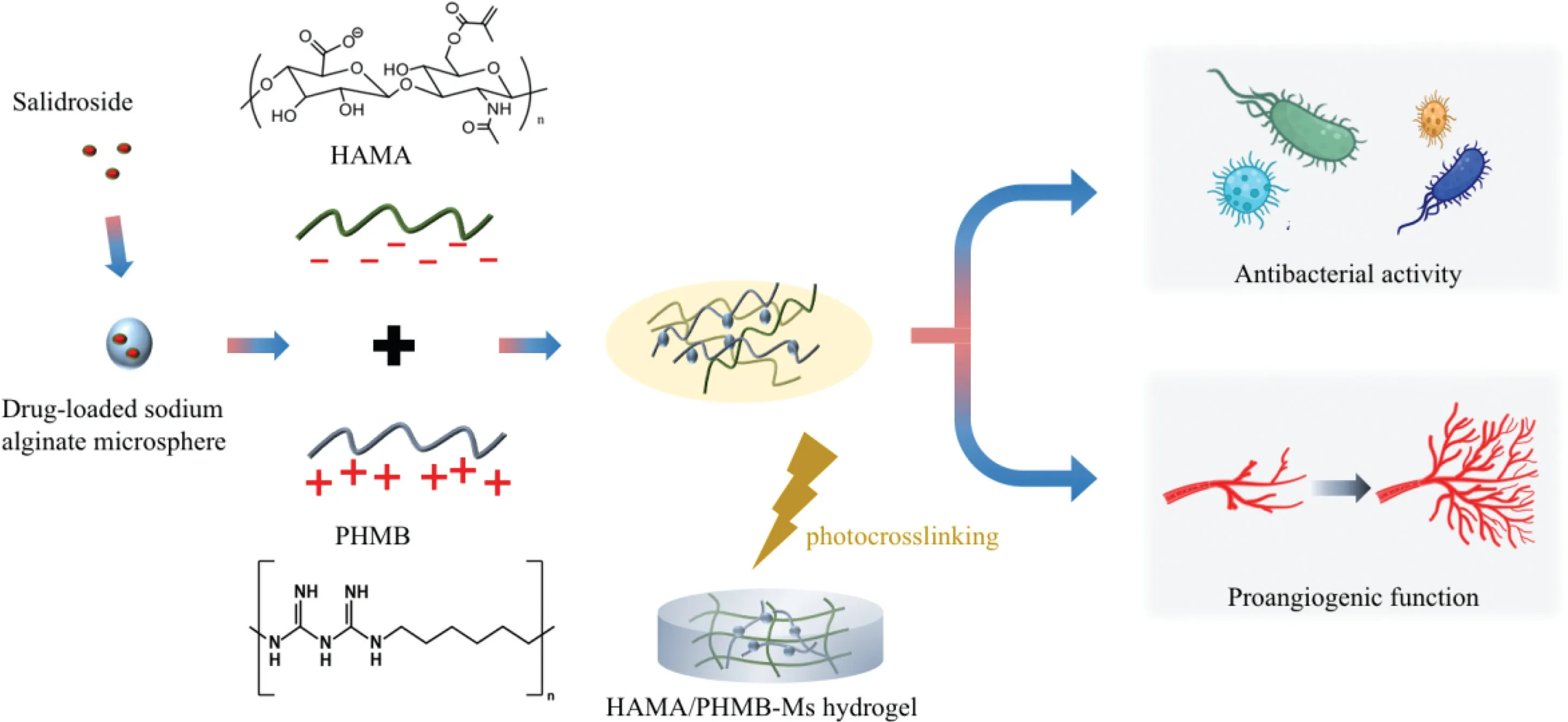
Fig.1.Schematic synthetic process of HAMA/PHMB-Ms hydrogel with antibacterial activity,proangiogenic function and application in diabetic wound healing.
In this work,an antibacterial and proangiogenic dual-function hydrogel wound dressing was prepared(Fig.1).Hyaluronic acid was chemically modified by methacrylic anhydride and used as a hydrogel matrix(HAMA),and polyhexamethylene biguanide(PHMB)was added as an antibacterial substance[19].According to the design,the cationic polymer PHMB was bound to the anionic polymer HAMA through electrostatic attraction.Salidroside,which has been clinically proven to possess antioxidant,anti-inflammatory and angiogenic effects[20],was loaded into sodium alginate microspheres to synthesize drug-sustained releasing microspheres[21].With the assistance of 2–hydroxy-4′-(2-hydroxyethoxy)-2-methylpropiophenone photoinitiator,the hybrid hydrogel precursor formed by mixing all reactants was successfully gelledin situby photocrosslinking,synthesizing a threedimensional hydrogel(HAMA/PHMB-Ms)that fits the skin.All the desirable properties including pro-angiogenic and antibacterial activity enhanced the practicality of HAMA/PHMB-Ms hydrogels and expanded the application scenarios for treating diabetic wounds.
1H nuclear magnetic resonance(1H NMR)spectrum and Fourier transform infrared(FT-IR)spectrum confirmed the chemical structure of the hydrogel components.Through the analysis of particle size distribution,the optimal composition ratio of sodium alginate drug-loaded microspheres was explored.Scanning electron microscope(SEM)was used to observe the morphology and pore structure of the hydrogel system.Gram-negative bacteria(Escherichia coli)and Gram-positive bacteria(Staphylococcus aureus)were cocultured with the hydrogel to evaluate the antibacterial activity.The cell viability test was used to study the cytotoxicity of the dual-functional hydrogel system.The wound healing and vascularization function were evaluated on the skin wound model of diabetic rats.This experiment was approved by the Ethics Committee of West China Hospital of Stomatology,Sichuan University(WCHSIRB-D-2022–010).Related experimental procedures are provided in Supporting information.
As shown in Fig.S1(Supporting information),HAMA has been verified by1H NMR that additional peaks appear at 6.02 ppm and 5.59 ppm,suggesting that the hyaluronic acid has been modified by methacrylic anhydride[22],confirming that HAMA has been successfully synthesized.
In order to achieve the accuracy of the drug loading of the microspheres and the uniformity of the microspheres in the hydrogel,we further explored the optimal concentration of sodium alginate microspheres.Through the analysis of particle size distribution in Fig.S2(Supporting information),it can be concluded that the particle size distribution of sodium alginate microspheres with a concentration of 1.5%was the most concentrated and approximately uniform distribution.Next,as shown in Fig.2A,the microspheres with a concentration of 1.5%were selected,the optimal drug loading ratio of sodium alginate/salidroside composite microspheres was further determined to be 3%through particle size analysis.In summary,the sodium alginate/salidroside composite microspheres with a sodium alginate concentration of 1.5%and a salidroside mass ratio of 3%were finally prepared.
The macroscopic structure of the hydrogel was shown in Fig.2B.The composition was semi-transparent and not easy to collapse,so that the healing of the wound could be easily observed,which was essential for clinical treatment.From a microscopic point of view,the morphology and size distribution of HAMA hydrogels were characterized by SEM in Fig.2C.The uniform and regular porous structure promoted the exchange of gas and nutrients.However,the hyaluronic acid-methacrylic anhydride matrix loaded polyhexamethylene biguanide(HAMA/PHMB)exhibited flocculent precipitates due to the mixture of antibacterial drugs,resulting in elliptical and sparse pores in the hydrogel structure.
The FT-IR spectra of PHMB and HAMA/PHMB hydrogels were shown in Fig.S3(Supporting information).It indicated that the PHMB and HAMA were successfully combined in the hydrogel,which provided the basis for the antibacterial activity of the HAMA/PHMB hydrogel.
As depicted in Fig.2D,in the early stage,the rapid dissolution of the antibacterial drug PHMB caused a greater mass loss than the water absorption of the hydrogel,resulting in a decrease of the total mass and the development of an antibacterial environment.The hydrogel gradually absorbed water ensuing swelling in the later stage.In summary,the system could well maintain its swelling and water absorption properties.
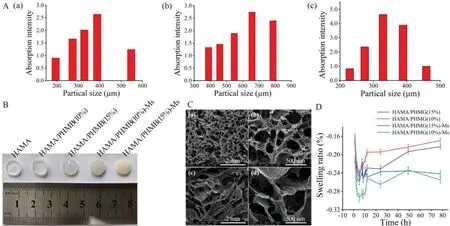
Fig.2.Characterization of the formation of obtained hybrid hydrogels:(A)Particle size distribution analysis of the salidroside loading ratio of(a)1.0%,(b)2.0%,and(c)3.0%sodium alginate microsphere;(B)morphology of obtained hybrid hydrogels;(C)SEM images of(a,b)HAMA and(c,d)HAMA/PHMB hydrogel;(D)the swelling ratio of hydrogels.HAMA,hyaluronic acid-methacrylic anhydride;PHMB,polyhexamethylene biguanide.
A locally sterile environment is essential for wound healing[18].The presence ofE.coliandS.aureuscan form a biofilm that causes wound infection.The antibacterial activity of the hydrogels was studiedviaco-culturing the most common skin infected species(E.coliandS.aureus)with the hydrogels,and the bacterial growth was observed by a plate counting method.In this study,HAMA,HAMA/PHMB(10%and 15%),HAMA/PHMB(10%and 15%)-Ms hydrogels were selected for antibacterial testing.The growth ofE.coliandS.aureuscolonies on agar plates and the antibacterial rate of different groups were laid out in Figs.3A and B.It can be recognized from the figure that the antibacterial rates of bothE.coliandS.aureusincubated in blank and HAMA were relatively low in that the bacteria proliferated freely with the incubation time.In contrast,after incubation with HAMA/PHMB and HAMA/PHMB-Ms with different PHMB concentrations,the bacterial viability decreased significantly.Expectedly,all the HAMA hydrogel groups mixed with PHMB displayed good antibacterial activity.These results indicated that the HAMA/PHMB hydrogel could effectively inhibit the growth ofE.coliandS.aureus.We speculated that the internal structure of bacteria was disrupted in response to PHMB,resulting in slow bacterial proliferation.
The antibacterial activity of PHMB has expanded its application in the biological field[19].However,the concentration of PHMB in wound healing treatment needs to be optimized,because high doses may cause toxicity to organs or tissues.To further study the antibacterial activity of the HAMA/PHMB hydrogel,the inhibition effects of HAMA/PHMB and HAMA/PHMB-Ms hydrogels with different PHMB concentrations on bacterial growth were recorded.Thus,we measured the antibacterial rate of the abovementioned bacterial liquid medium with different hydrogels at the same time interval.The bactericidal rates of HAMA/PHMB(10%)againstE.coliandS.aureuswere 93.73%and 92.75%,respectively.HAMA/PHMB(15%)had 96.61%and 97.10%antibacterial rates againstE.coliandS.aureus,respectively.HAMA/PHMB(15%)-Ms had 97.85%and 98.56%antibacterial rates againstE.coliandS.aureus,respectively.There was a significant difference between the HAMA/PHMB(10%and 15%),HAMA/PHMB(10%and 15%)-Ms and HAMA hydrogel groups(P<0.01).The results powerfully demonstrated that HAMA/PHMB and HAMA/PHMB-Ms hydrogels exhibited antibacterial ability,which increased with increasing levels of antibacterial constituents.These results were consistent with the results observed through plate dilution coating,and further confirmed that the introduction of a higher concentration of PHMB into the hydrogel effectively enhanced the antibacterial properties of the hydrogel.
Interestingly,the antibacterial ability of HAMA/PHMB hydrogels containing microspheres was better than that with PHMB alone(97.85%vs.96.61%).On the one hand,we suspected that the mechanism could be explained by the positive charge of microspheres,which could damage the membrane structure of bacteria by disturbing the surface potential[23,24].On the other hand,natural phenolic compounds from various sources such as salidroside have been shown to have potential antibacterial properties[25].Therefore,HAMA/PHMB(10%and 15%)and HAMA/PHMB(10%and 15%)-Ms hydrogels exhibited satisfactory antibacterial properties by resisting the invasion of external bacteria and inhibiting the activity and growth of bacteria.
In addition to antibacterial activity,biocompatibility is an important metric used to evaluate the application of hydrogels as wound dressings.As shown in the results of cell counting kit-8(CCK-8)in Fig.3C,the cell survival rate slowly increased with prolonged culture time and ranged from 86.07%to 91.75%.The results revealed that all the hydrogel groups had low cytotoxicity.After two days of culture,the survival rate of L929 cells on HAMA/PHMB(15%)hydrogels was relatively lower than the HAMA/PHMB(10%)hydrogel and control group.We hypothesized that antimicrobial components have some side effects on normal cells while inhibiting bacterial activity.In short,we found that mixing an appropriate amount of PHMB and drug-loaded microspheres had no significant effect on cell proliferation activity.
The CCK-8 results were further confirmed by calcein-AM/PI double staining assay.As shown in Fig.3D,the fluorescence distribution clearly showed that the viable cells stained with green in the blank and HAMA groups were almost equal.All groups showed high adherent cell density and the number of cells increased gradually with time,and few cells were stained with red fluorescence.It suggested that all hydrogels had good cytocompatibility.Moreover,the density of green-stained cells in the HAMA/PHMB(15%)group was relatively low on day 2,but there were no differences between the groups,which were consistent with the results of CCK-8.The results verified that the hydrogel had good biocompatibility and low cytotoxicity to fibroblasts.
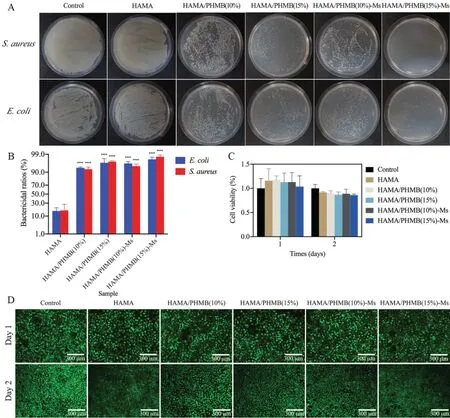
Fig.3.(A)Composite hydrogels grown on agar plates after incubation with E.coli and S.aureus;(B)bactericidal rate of hybrid hydrogels;(C)cell viability of L929 cells cultured with extracts of hydrogels for 1 and 2 days;(D)fluorescence images of L929 cells cultured with extracts of hydrogels after 1 and 2 days.Magnification:4×;scale bar:300μm.
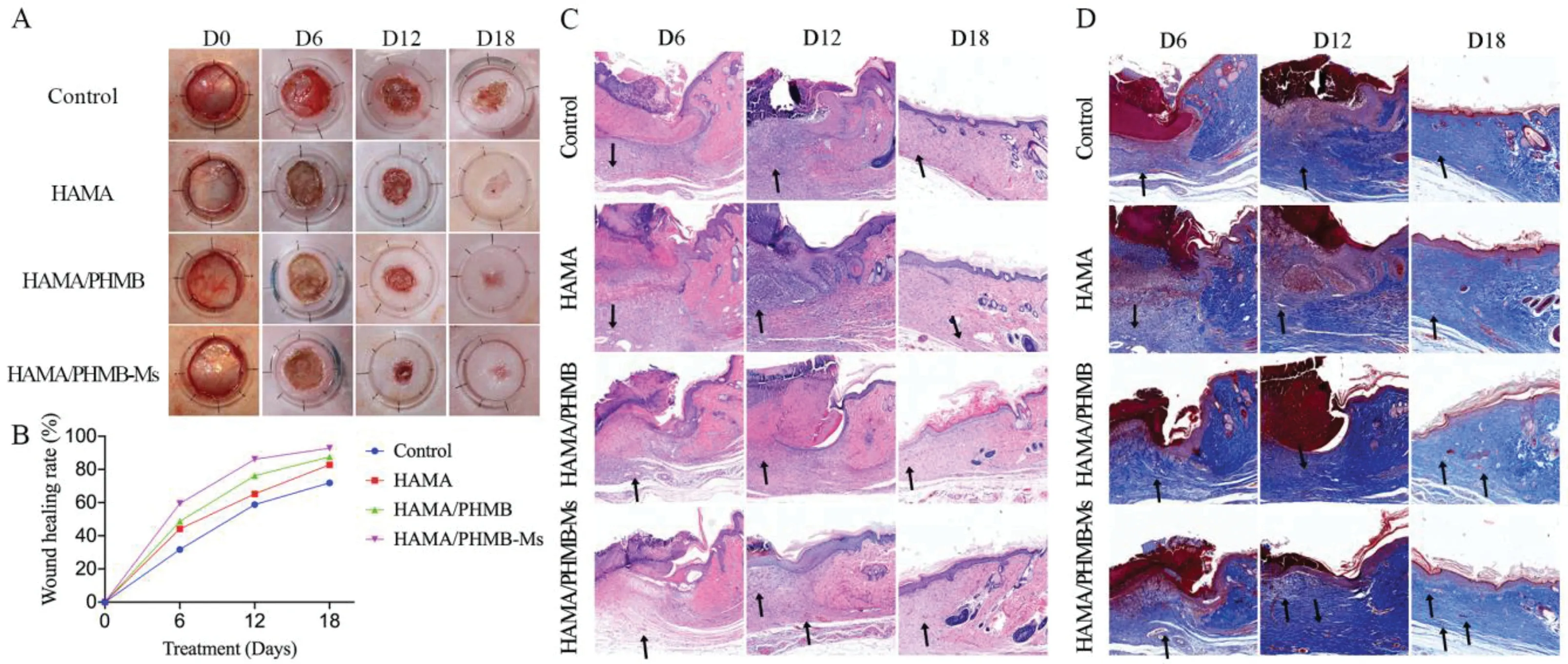
Fig.4.(A)Representative photographs of four types of treated wounds on days 0,6,12 and 18;(B)quantification of wound closure during 18 days;representative(C)H&E and(D)Masson trichrome staining images acquired on days 6,12 and 18 post-surgery(blood vessels:black arrows).
Subsequently,diabetic rat models were established by intraperitoneal injection of streptozotocin to study the therapeutic effect of hydrogels on the diabetic wound.The animals were divided into blank control group,HAMA hydrogel group,HAMA/PHMB(15%)hydrogel group,and HAMA/PHMB(15%)-Ms hydrogel group.Typical wound closure images at different time points were taken for each group in Fig.4A.After 18 days of observation,as expected,the wounds in the HAMA/PHMB(15%)-Ms hydrogel group healed best over time,but in both the control and HAMA groups,the wound surface was rather than healed due to their limited antibacterial properties and angiogenesis.To assess the healing rate of the diabetic wounds,the wound area was quantified to indicate the residual wound area in each experimental group at 0,6,12 and 18 days after surgery(Fig.4B).Expectedly,wounds covered by HAMA/PHMB(15%)-Ms hydrogel were almost completely healed(92.80%)within 18 days.In contrast,the wound healing area remained 71.89%and 82.78%in the control and HAMA groups,respectively,at 18 days.Consistent with gross observations,the HAMA/PHMB(15%)-Ms hydrogel-covered wounds healed significantly faster than the control and HAMA groups throughout the healing process(P<0.05).These results suggested that combining antimicrobials and proangiogenic agents could synergistically promote wound healing.
The histological results of the diabetic wounds were consistent with the wound contraction observed by optical images.As shown in Fig.4C,hematoxylin and eosin(H&E)staining showed that HAMA/PHMB(15%)-Ms hydrogel significantly enhanced the replacement of well-organized granulation tissue at the wound site on day 6.On day 12,as more granulation tissue and more new subcutaneous capillaries increased in HAMA/PHMB(15%)-Ms group,the structure became denser.In contrast,the wounds of the control group and the HAMA group had necrotic tissues and less granulation tissue on the 6thand 12thdays.This was due to insuffi-cient wound protection and biofilm adhesion.The results clearly showed that after 18 days,compared with the control group and the HAMA group,more new capillaries were formed in wound healing after HAMA/PHMB(15%)-Ms hydrogel treatment.In the process of normal wound repair,collagen deposition played a significant role in scar formation,and the wound shrank due to the crosslinking of fibroblasts and collagen.Considering this,Masson trichrome staining was performed to detect newly formed collagen deposits in the regenerated skin tissue(Fig.4D).Although limited collagen was observed at the wound edge on day 6,collagen deposition in the HAMA/PHMB(15%)-Ms hydrogel group was more significant than in the control and HAMA groups.On day 18,the collagen deposition in the HAMA/PHMB(15%)-Ms hydrogel group further thickened,verifying that drug-loaded microspheres applied to diabetic wounds could promote fibrosis.In contrast,the collagen deposition around the wound in the control group was still limited.Therefore,the HAMA/PHMB-Ms hydrogel wound dressing effectively promoted the healing of the diabetic wounds and could become an important candidate for a new type of diabetic wound dressing.
In conclusion,we successfully synthesized HAMA and sodium alginate/salidroside composite microspheres.An appropriate proportion of antibacterial agents PHMB and drug-loaded microspheres were added to the hydrogel matrix,and hydrogels were prepared by photocrosslinking to explore their role in the healing process of the diabetic wounds.The results showed that by introducing antibacterial agents,the antibacterial performance of the hydrogel system could be well adjusted.The application prospects in infected wounds are undoubtedly broad.More importantly,through gross and microscopic staining observation,it was found that the drug-loaded hybrid hydrogel had the effects of promoting vascularization and fibrosis in the healing process of the diabetic wounds.As expected,the salidroside in the drug-loaded microspheres successfully accelerated the healing of the diabetic wounds by promoting granulation tissue formation,collagen deposition and angiogenesis.This article aims to provide new ideas and methods for the research and development of the diabetic wound hydrogel dressings.
Declaration of competing interest
The authors declare that they have no known competing financial interests or personal relationships that could have appeared to influence the work reported in this paper.
Acknowledgments
This work was supported by the National Natural Science Foundation of China(No.52103039),Medical Science and Technology Project of Sichuan Provincial Health Commission(No.21PJ059),Science and Technology Application Fundamental Project of Sichuan Province(No.2019YJ0724),Sichuan University Postdoctoral Interdisciplinary Innovation Fund.
Supplementary materials
Supplementary material associated with this article can be found,in the online version,at doi:10.1016/j.cclet.2022.03.116.
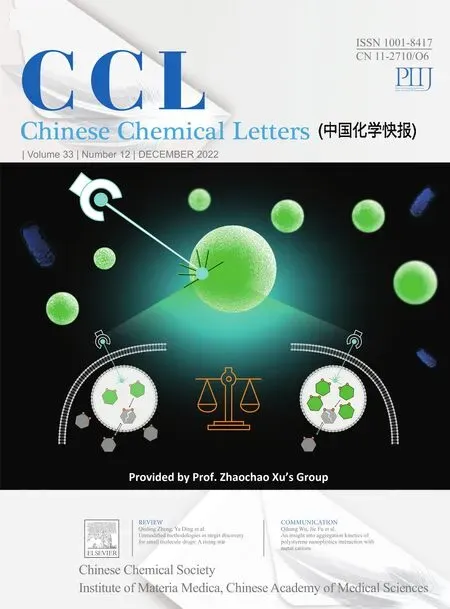 Chinese Chemical Letters2022年12期
Chinese Chemical Letters2022年12期
- Chinese Chemical Letters的其它文章
- Diverse strategic approaches en route to Taxol total synthesis
- Recent advances in gold-complex and chiral organocatalyst cooperative catalysis for asymmetric alkyne functionalization
- Unmodified methodologies in target discovery for small molecule drugs:A rising star
- Recent advances in single-crystalline two-dimensional polymers:Synthesis,characterization and challenges
- Environmental applications of graphene oxide composite membranes
- Recent advances in the application of metal organic frameworks using in advanced oxidation progresses for pollutants degradation
